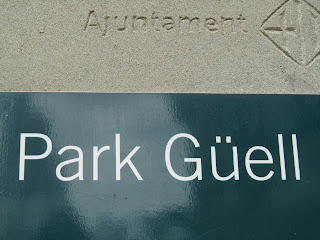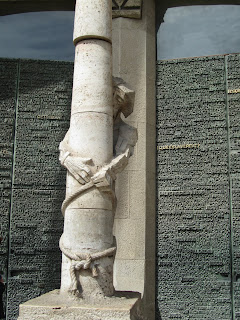Let me back track a bit. . . We took a bus from Sevilla to Granada, for some sight-seeing. Granada sits at about 2500 ft. elevation at the foot of the Sierra Nevada mountains, only an hour from the Mediterranean coast. One of the most famous buildings of the Islamic historical legacy, The Alhambra, is in Granada. This Moorish citadel and palace, makes the city a hot spot among cultural and tourist cities in Spain.


I really enjoyed our tour of The Alhambra and the history behind it. For a literature teacher, I especially liked hearing the anecdote about esteemed American author, Washington Irving, and his stay in Granada. According to our guide, in 1829, Irving was granted access to Alhambra for inspiration in writing some fictional stories that would introduce Spain, Granada, and The Alhambra to Western audiences. When his book, Tales of the Alhambra was published in the 1830's, it revived tourism in Granada and surrounding areas. There is a plaque that hangs in the room where Irving stayed while he was writing to commemorate his influence.
Anyway, here are a few more pictures from the gardens. It was beautiful and I could have spent the entire day just searching out every little spot in the place.




From Granada, we took the overnight train to Barcelona (I couldn't get Agatha Christie's Murder on the Orient Express out of my mind). It was approximately 12 hours of train-rocking fun/sleep as we traveled north to our destination. The train stopped every now and again for passengers hopping off or boarding. . .even at 2:00am. Quite an interesting experience. In my sleeping car, I had two South Korean girls who were traveling through Europe on a "fly-by-the-seat-of-their-pants" adventure. They didn't speak any Spanish and very little English, but they seemed to be having a good time. Here is a picture of my room and the train sign. Good times!


Upon arrival in Barcelona, we checked into our hotel, then took a little walking tour of the central part of the city. Barcelona is one of the coolest cities I've been to in Europe. I'm not sure I can do it justice so, again, I'll try to show you in pictures. (But even then, you're better off to visit for yourself.)
First stop. . .the mercado (marketplace) where you could purchase fresh produce, seafood, candy, wine and other delicacies.





After the stop at the market we took a trip around the gothic part of Barcelona. There always seem to be some beautiful chapels, museums and other structures in the older sections of Spanish cities. However, after a visit to a great park, the most famous landmark in Barcelona was our next destination.
The "Templo Expiatorio de la Sagrada Familia" (Expiatory Temple of the Holy Family) is an incredible cathedral that is still in the process of completion. That's right. . . they're still working on this magnificent structure. The first blocks of stone were put in place in 1882 and famous Spaniard artist/architect/genius Antoni Gaudí took over the project a year later. You can read more about Gaudí here and here. We were lucky enough to spend some time at both Park Güell and La Sagrada Familia.


 Not sure who those two are in the background, but I loved Gaudi's rock-work.
Not sure who those two are in the background, but I loved Gaudi's rock-work.Next was La Sagrada Familia. Simply incredible.
I can't do it justice with words, but here's a brief synopsis just about the façades of the cathedral. . . and some of my pics. "The Church will have three grand façades: the Nativity façade to the East, the Glory façade to the South (yet to be completed) and the Passion façade to the West. The Nativity façade was built before work was interrupted in 1935 and bears the most direct Gaudí influence. The Passion façade is especially striking for its spare, gaunt, tormented characters, including emaciated figures of Christ being flogged and on the crucifix. These controversial designs are the work of Josep Maria Subirachs. The Glory Façade, which began construction in 2002, will be the largest and most monumental of the three and will represent one’s ascension to God. It will also depict various scenes such as Hell, Purgatory, and will include elements such as the Seven Deadly Sins and the Seven Virtues." (Source: Wikipedia)


Here's the ONW part of our group on the Nativity side of the cathedral. You can see that the Sagrada Familia just dwarfs us.
 Mary, Joseph and the baby Jesus in the manger scene. And below you have the three wise men and the flight to Egypt that followed Herod's decree.
Mary, Joseph and the baby Jesus in the manger scene. And below you have the three wise men and the flight to Egypt that followed Herod's decree.


And, now here are the pictures of the inside of the cathedral (still under construction) and the Passion façade. Again, it's hard for me to describe everything. If you have the opportunity to travel to Barcelona you must see this site.





 Above are depictions of Peter's denial and Judas' betrayal.
Above are depictions of Peter's denial and Judas' betrayal. Our final excursion before heading home included a trip to the beach and a general free day to roam around Barcelona. It was a relaxing way to end a memorable trip! (Some time I'll tell you about the thief from the beach and our own "Don Quixote and Sancho Panza" who chased the man through the streets.)

Except for the Spanish loss to the Swiss in pool play at the World Cup on our last day in the country, my trip to Spain couldn't have been any better. (And obviously, Espana has recovered to do quite nicely.)
Thanks for reading my ramblings; I leave you with this little saying:
How beautiful it is to do nothing, and then rest afterward.
Spanish Proverb




















